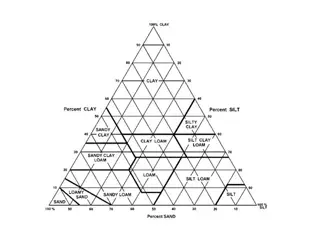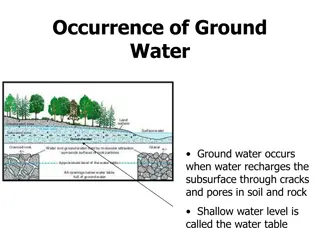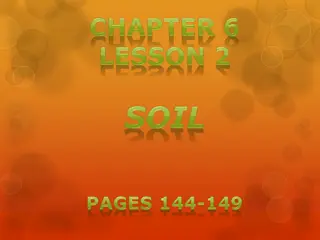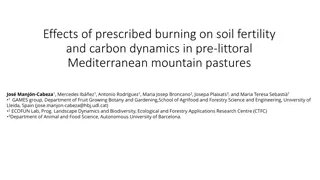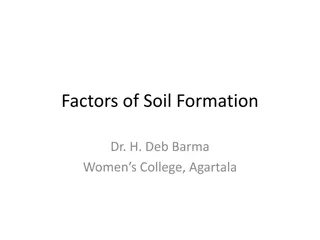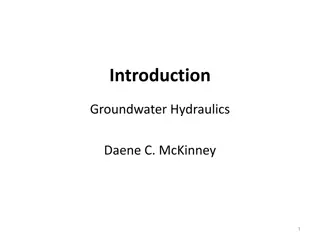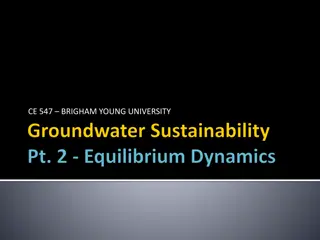Sustainable Use of Groundwater
Groundwater management and sustainable use are crucial in India, as highlighted by the Ministry of Jal Shakti. The country faces challenges such as declining groundwater levels, quality deterioration, and increasing demand-supply gaps. Effective strategies and responsible practices are needed to add
0 views • 20 slides
Understanding Principles and Practices of Water Management in Agriculture
This course delves into the field water cycle, water movement in soil and plants, soil-plant-water relationships, water dynamics in the soil-plant-atmosphere system, soil composition, soil texture classification, permeability factors, density of soil solids, total porosity assessment, and energy asp
8 views • 62 slides
Effective Methods for Soil Conservation
Methods to reduce soil erosion and promote soil conservation include terracing, contour planting, strip cropping with cover crops, alley cropping, agroforestry, windbreaks, and conservation tillage practices such as no-till and minimum tillage. These methods help in minimizing soil erosion hotspots
2 views • 11 slides
Groundwater Recharge Station Project
The Groundwater Recharge Station Project, Project Number 21-381, at California State University, Stanislaus involves the construction of a groundwater recharge station. The notice to contractors provides details on bid proposals, project scope, budget estimate, project duration, and prequalification
0 views • 19 slides
Microplastic Occurrence in South Korean Groundwater by Well Depth and Hydrogeology
The study conducted by Kangwon National University in South Korea analyzed microplastic occurrence in groundwater from wells of varying depths and hydrogeological settings. Samples were collected from the National Groundwater Monitoring Network pipes in Gapyeong and Chuncheon. Water type analysis re
7 views • 6 slides
Understanding the Importance of Humus in Soil Health
Humus, the organic residue in soil, plays a crucial role in soil fertility and plant growth. It improves soil structure, retains water, stores essential nutrients, and promotes microbial activity. Factors like soil fertility, moisture, temperature, and pH influence the distribution and activity of s
0 views • 21 slides
Understanding Groundwater: Occurrence, Recharge, and Movement
Groundwater occurs when water seeps into the subsurface through cracks and pores in rocks and soil, forming the water table. Recharge happens naturally through processes like precipitation and snowmelt, as well as artificially through methods like recharge wells and water spread over land. The movem
0 views • 8 slides
Groundwater Suitability Mapping Training Overview
The training program focuses on GIS and Remote Sensing for overlay analysis, with an emphasis on generating groundwater suitability maps. Dr. Maarten Waterloo leads the session, covering topics like data processing, automation, and sensitivity analysis. The program includes hands-on activities and e
0 views • 14 slides
Soil Disinfestation Methods for Greenhouse Crop Production
Soil mixes for greenhouse production are carefully designed to optimize water retention and aeration. Proper management of artificial soil mixes can yield crops equal to those grown in topsoil. Sterilization of growing media is crucial, with techniques such as steam sterilization and fumigation comm
0 views • 11 slides
Understanding Soil Chemistry and Redox Reactions in Environmental Chemistry
Soil chemistry plays a crucial role in sustaining healthy soils by influencing nutrient availability through oxidation and reduction processes. Redox reactions in soil are impacted by factors like oxygen content and water presence, affecting nutrient supplies. The redox status of soil reflects its n
1 views • 92 slides
Understanding the Diversity of Microorganisms in Soil Ecosystems
Microorganisms in soil play crucial roles in soil fertility, nutrient cycling, and industrial product synthesis. They can also be pathogens causing diseases in plants and humans. Soil organisms are broadly classified into two groups: soil flora and soil fauna, consisting of various microorganisms li
0 views • 57 slides
Understanding Soil Composition and Importance
Explore the world of soil and its significance as a natural resource by discovering its composition and how it affects plant growth. Learn about the main ingredients of soil, its permeability, and the role of water, air, and organic matter. Gain insights into how soil supports plant life through lea
1 views • 30 slides
Sustainable Groundwater Management in Stanislaus County: A Comprehensive Overview
Long-term groundwater replenishment programs, pumping policies, and the Sustainable Groundwater Management Act (SGMA) are crucial for managing water resources in Stanislaus County. The Modesto Irrigation District's (MID) efforts in conjunctive use, groundwater recharge projects, and public outreach
2 views • 10 slides
Understanding the Importance of Soil and Groundwater Measurements
Explore the significance of infiltration and hydraulic conductivity measurements in environmental studies, training sessions offered by Eijkelkamp Training & Consultancy, and various reasons for conducting measurements such as defining drain distance, disconnecting rainwater, soil and groundwater po
0 views • 55 slides
San Benito County Water District Groundwater Sustainability Agency Technical Advisory Committee Meeting Summary
The San Benito County Water District Groundwater Sustainability Agency Technical Advisory Committee met on August 26, 2020, to discuss various topics including update on GSP schedule, setting sustainability criteria, and monitoring for subsidence issues. The meeting highlighted the need for more sys
0 views • 33 slides
Understanding Soil Erosion and Conservation in 6th Grade Science
Soil erosion is the process of soil wearing away, commonly caused by natural forces like wind, water, gravity, and ice, as well as human activities such as farming, mining, and construction. Severe weather events can accelerate soil erosion. Soil conservation techniques like crop rotation, conservat
0 views • 12 slides
Soil Chemistry and Mineralogy Analysis at CSU Summer Soil Institute
Explore the comprehensive analysis of soil chemistry, texture, and mineralogy conducted at the CSU Summer Soil Institute in July 2010. The study delves into pedology, elemental composition, particle size distribution, X-ray diffractometry, and mineralogical composition of various soil samples. Detai
0 views • 22 slides
Understanding Soil Characteristics and Ecosystem Interactions
This content explores various aspects of soil characteristics, including factors influencing soil thickness, the role of bedrock in soil quality, optimal soil mixtures for plant growth, the impact of living organisms on weathering, and the formation of soil. It also discusses how animals can help so
0 views • 17 slides
Understanding Soil: Formation, Composition, and Impact on Plant Growth
Soil is more than just dirt; it plays a vital role in supporting plant growth. Formed through the weathering of rocks and organic activity, soil consists of rock fragments, clay, and organic material. The process of soil formation begins with the erosion of bedrock, leading to the development of dif
0 views • 12 slides
Exploring the Fascinating World of Soil: An Insightful Journey
Delve into the intricate composition of soil through a hand lens to uncover rocks, minerals, and humus. Discover the hidden elements like water, air, and living organisms that form the foundation of soil. Witness the decomposition process by bacteria and fungi, and explore the layers of a soil profi
0 views • 15 slides
Impacts of Prescribed Burning on Soil Fertility in Mediterranean Pastures
This study investigates the effects of prescribed burning on soil fertility and carbon dynamics in Mediterranean mountain pastures. It explores how soil responds to disturbance by prescribed burning, potential legacy effects based on pre-burning conditions, and the role of local microtopography in s
0 views • 8 slides
Virtual Groundwater Research Lab Solutions
CeRDI from the Centre for eResearch and Digital Innovation focuses on creating virtual groundwater research laboratories using interoperable technologies. They address challenges such as providing access to complex data, incorporating qualitative and quantitative data into models accurately, harness
0 views • 21 slides
Understanding Factors of Soil Formation and Soil Geography
Soil formation is a complex process influenced by factors like weathering, organic matter, and minerals. Soil geography studies soil distribution using geographic methods and cartography. Various definitions of soil highlight its importance for plant growth and as a natural body with distinct horizo
0 views • 20 slides
Iron and Manganese Removal from Groundwater Study
Iron and manganese are common natural elements in groundwater, but their presence can lead to various issues such as metallic taste, staining of clothes and fixtures, and growth of iron bacteria. This study aims to analyze groundwater wells in Libya, identify high levels of iron and manganese, and p
0 views • 29 slides
Understanding Soil Health for Sustainable Ecosystems
Soil health, defined as the capacity of soil to function as a living ecosystem supporting plants, animals, and humans, is crucial for sustaining life. This content explores the imperatives, opportunities, and key practices such as no-till and cover crops to enhance soil health. It also delves into d
0 views • 33 slides
Enhancing Flow Opportunities in Scott Valley Groundwater Study
The Scott Valley Groundwater Study identifies flow enhancement opportunities to improve water management and increase stream flows. Initiatives include developing an integrated hydrologic model, exploring water management strategies, and implementing groundwater recharge projects since 2008. The stu
0 views • 6 slides
Long-Term Management of Contaminated Soil and Groundwater in Iwilei District, Honolulu
The Iwilei District in Honolulu, Hawaii, spans 315 acres with multiple landowners and responsible parties. It features commercial and industrial use, including bulk fuel terminals, former MGP site, active/inactive petroleum pipelines, and Dole Cannery. The area has been impacted by petroleum-contami
0 views • 25 slides
Human Impacts on Groundwater Systems in Minnesota: A Study of Interactions and Solutions
Explore the intricate relationships between human activities and groundwater systems in Minnesota through investigations, models, and technological solutions. Utilize place-based evidence, including insights from Minnesota American Indian tribes and cultures, to understand and address climate change
0 views • 7 slides
Microbial Transformations of Nitrogen in Soil: Factors, Forms, and Impact on Plant Nutrition
Understanding the microbial transformations of nitrogen in soil is crucial for optimizing plant nutrition. Factors such as climate, water supply, cultivation, soil texture, and depth influence the nitrogen content in soil. The different forms of soil nitrogen, including inorganic and organic compoun
0 views • 23 slides
Understanding the Role of Soil Biology in Lawn Care
Soil biology plays a crucial role in maintaining healthy and vibrant lawns. Various organisms, including invertebrates, plant roots, mycorrhizae, and micro-organisms, contribute to functions such as soil structure maintenance, regulation of soil hydrological processes, gas exchange, carbon sequestra
0 views • 27 slides
Importance of Describing Soil Profiles for Soil Suitability Analysis
Proper classification and interpretation of soil properties through describing soil profiles are essential in determining soil suitability for various uses. Soil classification involves describing, classifying, and interpreting soil properties to understand the best uses and limitations of the soil.
0 views • 5 slides
Redox Conditions and pH Control in a Mountain Watershed: Study in Red Canyon, Wyoming, USA
Exploring redox conditions and trace element concentrations in a semi-arid mountain watershed, this study in Red Canyon, Wyoming, delves into the impact of oxic surface water and anoxic groundwater on trace element cycling. The investigation aims to enhance understanding of seasonal variabilities, f
0 views • 11 slides
Understanding Groundwater Hydraulics and Hydrology
Explore the fundamentals of groundwater hydraulics and hydrology in this course, covering topics such as Darcy's law, aquifer testing, unsaturated flow, and more. Dive into practical applications and participate in a team project focusing on limiting hydraulic containment of contaminated aquifers. G
0 views • 25 slides
Enhanced Groundwater Recharge Technologies Overview
This presentation on Enhanced Groundwater Recharge Technologies covers a range of topics including background information, local assessments, groundwater recharge zones, and opportunities in Stanislaus County. It delves into various methods such as drywells, spreading basins, and aquifer storage, as
0 views • 9 slides
Enhancing Groundwater Governance and Cooperation in Phase 2 of GGRETA Project
The proposed Phase 2 of the GGRETA Project aims to improve groundwater governance, develop gender-responsive water approaches, and enhance cooperation on water security in countries like El Salvador, Honduras, South Africa, and others. The objectives include improving resource knowledge, fostering c
0 views • 5 slides
Understanding Groundwater Hydrology Concepts at Brigham Young University
Explore the derivation of transient terms, specific storage mechanisms, and distinctions between specific storage, storativity, and specific yield in groundwater hydrology. Delve into the mathematical equations governing groundwater flow and storage, understanding the change in mass stored in the sy
0 views • 17 slides
Understanding Groundwater Sustainability and Equilibrium Dynamics
This content delves into the concepts of groundwater sustainability, equilibrium, and capture in relation to groundwater management. It explores transitional storage, groundwater mining, and debunks the water budget myth. The images and explanations illustrate how pumping affects aquifers, the evolu
0 views • 11 slides
Exploring the Critical Relationship Between Climate and Groundwater
Investigating groundwater as a vital global resource, this study delves into the profound impact of climate change on groundwater levels and quality. Highlighting challenges and solutions, it emphasizes the urgent need for sustainable groundwater management practices.
0 views • 21 slides
Understanding the Scope and Importance of Soil Microbiology in Ecosystems
Soil microbiology plays a significant role in supporting plant communities and maintaining soil health. Living organisms, both plant and animal types, form only a small fraction of soil mass but are crucial for processes like plant growth, organic matter decomposition, humus formation, and biogeoche
0 views • 14 slides
Understanding 4-Log Virus Treatment and Groundwater Rule Compliance
This collection of images and information delves into the importance of 4-log virus treatment under the Groundwater Rule, regulatory requirements for groundwater systems, the basics of Ct calculations for disinfection, types of disinfectants used, and understanding log inactivation of viruses. The c
0 views • 24 slides


